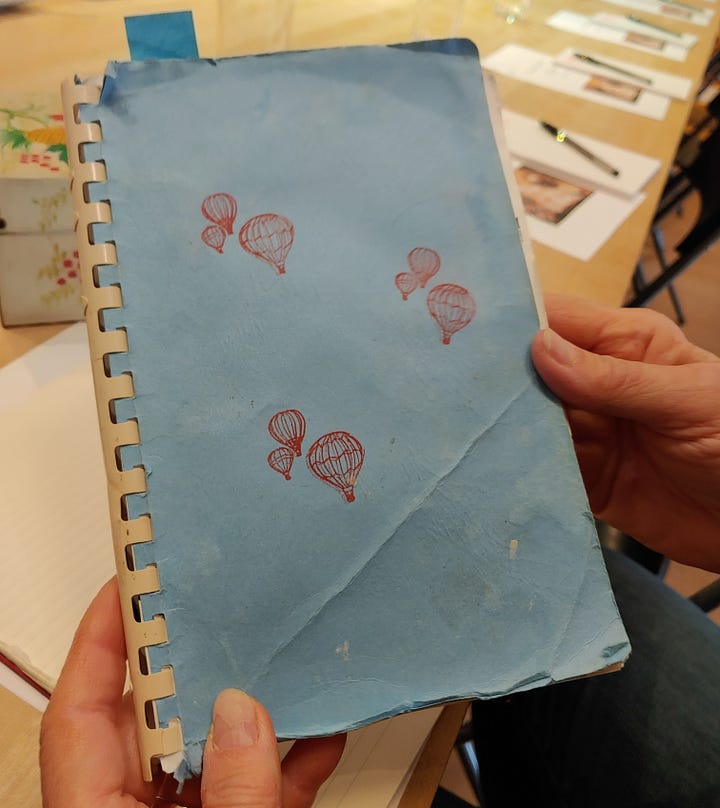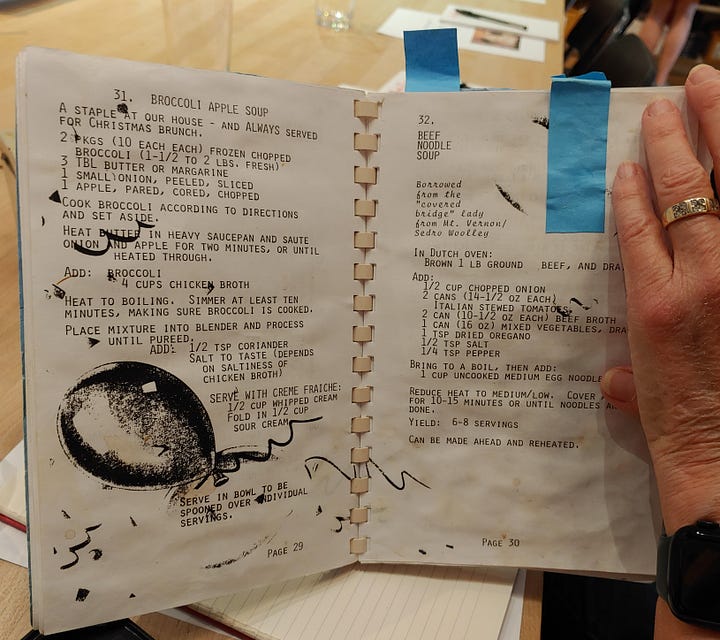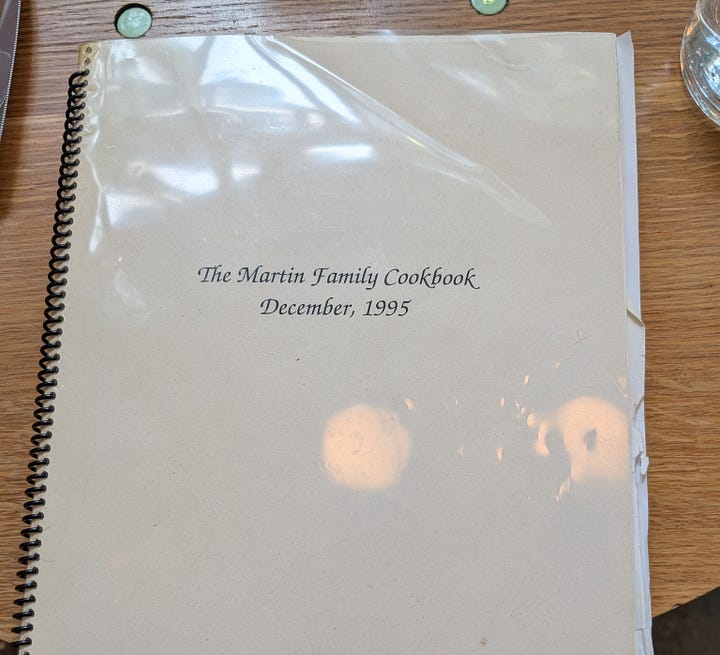Recreating Cherished Recipe Collections
After the gathering: printing beloved recipes to share with others
“You’re the spark, for sure. And you really sparked me. It was a really great way for me to look at my grandmother’s history.”
That’s how a conversation I had earlier this week began, with Ann who had been in a workshop I led at The Community Library in Ketchum, Idaho, last summer. I can’t say how much it meant to hear more about a small book she put together following the workshop—exactly the kind of encouragement I hope to leave folks with. The motivation to pull the dusty, long-forgotten recipes boxes/folders/books down off a shelf and ensure that at least some of the gems within are carried forward for future generations.
In Ann’s case, it was an old leather-bound recipe book of her grandmother’s in which were pages of hand-written recipes along with other recipe notes and clippings tucked inside. She pulled it off a shelf, dusted it off, and brought it to the workshop. I always invite attendees to bring in a couple of recipes, or folders, boxes, whatever they may feel compelled to have in class to represent cherished recipes they want to preserve and share with others. It’s among the things I love most about those workshops—one of the best versions of show-and-tell that I can think of.
The workshop inspired her to go through those recipes with her mom, who attended the workshop with her as well. As Ann explained, “My grandmother died when I was so young [3 years old], I never knew her. Getting to know her by her recipes was really a lot of fun.” It was a process during which that golden thing happened: conversations about recipes leading to conversations about life and memories and people and so many other things that those recipes can represent. It meant the world to her mom, too—the win-win that recipe conversations have for all involved!

For Christmas this past year, Ann gave her mom a book she put together with some recipes from her grandmother’s book, with stories and photos peppered among them.
On the practical side, Ann shared with me that she essentially put it all together as a Word document, with scans of her grandmother’s recipes and photos placed among the text and updated versions of the recipes that she wrote. Then she worked with a local copy shop to choose a printing/binding option and had a handful of copies made.
This question of what exactly to do “next” for those who want to create a book of some kind—large or small, a few copies or many—isn’t one I’ve spent a lot of time delving into. By far most of my focus has been on the “gathering” part of preserving cherished recipes. Collecting them in the first place, review of existing collections, ideas for what to do with the recipes to help give them life in our kitchens today, importance of getting the stories with the recipes, etc. etc. etc.
That being said, I’m definitely gathering notes, ideas, examples, resources that I pick up along the way, things to help fuel suggestions for possible paths. Among such examples I’ve seen of family books are these few, all older projects that remain go-to resources:
One attendee of a class brought a family cookbook she’d put together when she was young, a basic folder for 8 1/2 x 11 inch paper that you could get at an office supply store; the original one she did was based on recipes from her father’s side of the family, who she said were the better cooks; her mom felt left out and asked her to do one from her side of the family too!
My friend Molly came to a workshop with a book that her mother-in-law had put together years ago. As Molly explained it, “she actually typed the recipes on an old IBM Selectric, made copies and manually punched and collated the books!”
And my friend Lisa showed me a cookbook project that her aunt put together for the family. Many/most of the recipes have some attribution, such as those from her Oma. She’d clearly used a template of some sort, recipes included nutrition info, and spots for time and such that she didn’t fill in. Lisa has added, as one does, other recipes tucked among the pages, the book becoming a folder of sorts for other recipes.




I’m working on a list of the various options, tools, websites, resources that might be worth considering for custom projects like this. I haven’t done a ton of research about them all yet, but I gather some can be fill-in-the-template easy (but without much room for creative variations), others more of a blank slate that takes more time but with broader possibilities for design and style. And plenty of options in between.
Based on examples I’ve seen thus far, I like the idea of finding a local print shop, checking out what various paper sizes and binding options they have, and getting input from them about how best to prepare a document they can print for you.
That’s what I suggested another past attendee do for the project she’s been working on since my January workshop. She came to the class with a box full of recipes, most of which in zip-top bags, separated by categories. Her mom had passed away recently and she was heading up a project to put together a cookbook of her recipes to be given at her celebration of life later this year. It’s a big project, one she said she welcomes for the opportunity to reflect on and honor her mom as she goes through the steps. What a beautiful legacy that will be, sharing her mother’s recipes with family and friends.
I feel quite certain that many of you who read this may have produced some version of a cherished-recipe collection and will have some personal insights to share as well. If so, I’d be most appreciative if you dropped down to comments and tell a bit about what you put together and what tools and/or services you used to do so.




Long live the local print shop! Worth their weight in gold.
I love old family recipes as you know. That workshop must have been so meaningful and fun, too.